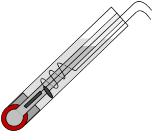Analytical Electrochemistry: Potentiometry
- Page ID
- 77966
This module provides an introduction to the measurement technique of potentiometry. It is intended to be a primary learning tool for a student in a Quantitative Analysis or Analytical Chemistry course and as a review resource for a student in Instrumental Analysis. It could also serve as a beginning resource for new practitioners.
If you have ever used a pH meter, then you have already performed potentiometry, an electrochemical method in which the potential of an electrochemical cell is measured while little to no current is passed through the sample. In a potentiometric measurement, an indicator electrode responds to changes in the activity, or “effective concentration” of the analyte. A potential, or voltage, that develops at the interface between the electrode and the analyte solution is measured relative to a reference electrode. This potential will be proportional to the amount of analyte in the sample. An illustration of one type of indicator electrode, the hydrogen ion or pH electrode, is shown below.

Ion-selective electrodes, or ISEs, are probably the most important class of indicator electrodes. As indicated by the name, ISEs possess a high degree of selectivity. These electrodes are routinely used in clinical laboratories to determine various ion concentrations (such as calcium) in blood samples. In fact, millions of measurements are made each year with the valinomycin K+ electrode in clinical assays. However, the applications of ISEs are not limited to clinical applications. ISEs are also regularly used in environmental analysis, such as in a water treatment plant to monitor nitrate levels.
The instrumentation used to perform potentiometry is straightforward, consisting of an indicator electrode, a reference electrode, and a potential measuring device. This simplicity makes potentiometry an inexpensive technique compared to atomic spectroscopy or ion chromatography. When making a potentiometric measurement, the sample typically experiences minimal perturbation. Additionally, measurements at ISEs are not affected by the color or turbidity of a sample, making them applicable to clinical and environmental applications, as noted above.
Before we get into more details about potentiometry and ion-selective electrodes, we will review some basic electrochemical theory that is needed to thoroughly understand potentiometric measurements. These topics include junction potentials, reference electrodes, and the Nernst equation. If you would also like a refresher on electrochemical cells and standard potentials, a companion concepts module is available.
Contributors and Attributions
- Erin M. Gross (Creighton University), Richard S. Kelly (East Stroudsburg University), and Donald M. Cannon, Jr. (University of Iowa)
This work is licensed under a Creative Commons Attribution-Noncommercial-Share Alike 2.5 License


